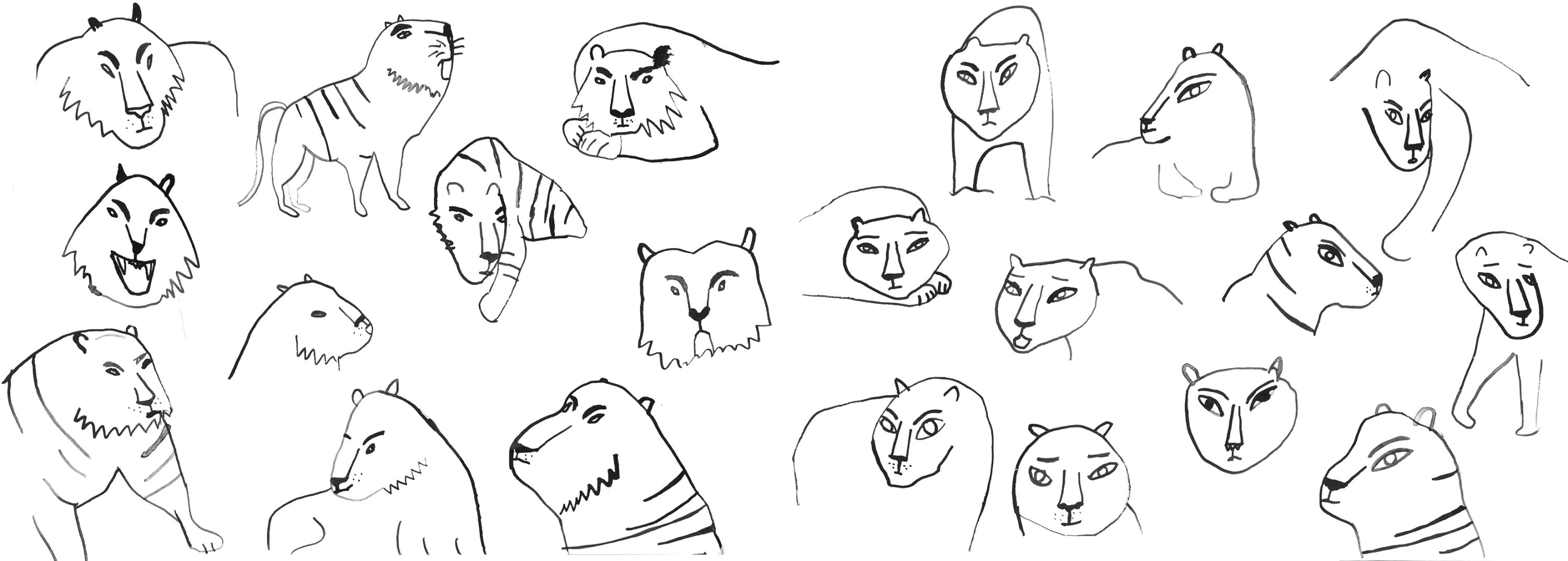The sounds of waves crashing and the faint echo of a windchime swinging. A black screen disappears to reveal a volcano erupting silently yet violently, turning the sun and the sky a deep shade of orange. This is how the scene is set for Anna Katalin Lovrity’s animated film Volcano Island, a story whose main character is its arresting scenery.
Anna was born and raised in Budapest, with a single mother who had strict views on raising a child. “We never had TV, and she never bought me Barbie dolls or anything like that,” Anna says. “But she always encouraged me to be creative instead, to draw and paint. I had nothing better to do!”
From this, Anna’s love of storytelling was born. She would write a lot as a child, mainly poetry, and took part in creative writing classes. “But I was always the girl in the class that liked to draw,” she says. Animation seemed an obvious path to combine her favorite things. In her later teenage years, she attended Budapest’s MOME, an art university.
Collage was another medium Anna spent time on growing up. When she was experimenting with cut-out animation, she would use the spare paper to create collages. “It had a great effect on my digital works when I was drawing on a computer,” she says. This is definitely visible in Volcano Island. The scenery has a collage feel to it, adding depth and layers to the forestry and flowers dotted around the film, bringing the island to life.
“I went hiking in Guadeloupe on holiday with my family, and the landscape was emotionally very moving,” Anna says. “From then on I knew that I wanted to create these emotions in an animated film. The story and the idea of the scenery as character really came together.” Volcano Island is more than just a pretty face, though. It’s a comment on sexual predators, harassment and on society in general, in a time when the conversation around consent is more poignant than ever.
Anna was reading an online forum about sexual abuse, and came across a comment that stated how young women can expect men to to try and sleep with them when they’re “dressed up like little whores.” This brought back memories from her teenage years. “When you’re a teenage girl you’re experimenting with your femininity, and it’s not because you want to seduce old men,” she says. “So I discussed it with a lot of my friends and we’d all had strange encounters with older men. We all felt trapped or ashamed because we felt like what had happened to us was our responsibility.”
When Anna was 15, an older man started a conversation with her on the train. He asked her what she wanted to become, and when she said she wanted to be a painter, he said he was a painter too, and invited her to come to his exhibitions under the guise of helping her with her work. The entire experience made Anna uncomfortable, but she felt that she had to be polite to him, and she didn’t want to be rude. “I couldn’t really recognise what was going on, and I thought maybe he just wanted to help me and that I should be grateful,” she says. “Eventually it all became very obvious, because we met and I wanted to go home and he wanted to kiss me. At 15 you are very naive, and I had only met respectable people before that.”
Drawing from this encounter, Volcano Island features a small young tiger who is pressured and manipulated by a much bigger, and clearly much older tiger. Anna’s own experiences left her well placed to comment on such a scenario, and the predatory tiger’s white coat is a nod to the man who harassed her at 15. “I chose the tiger to be white, because you associate that with something good. Something pure and innocent,” she says. “But just like with my experience, it’s a trap. The man in my own story had a son who was my age. I took it as an assurance. I thought, obviously he must see me as a child. But he didn’t.”

The film was a long process — Anna spent a year and a half on it — even though she had a lot of help. It was the first film she directed, and she enjoyed this as she doesn’t consider animation her greatest strength. “I just like to tell the stories and to think about how the associations are working, and how it will look good. But I don’t really like to actually animate,” she says. Anna did the layout, illustrated the scenery and the characters and created the main movements, while the frames between were done by the animators she directed. “I just like it when I have an idea and someone makes more out of it than I could ever have imagined.”
Anna wanted to make sure the film was as original as it could be. She didn’t do any research into what others had created to deal with these topics, or into other similar animated film. “It’s difficult not to be too influenced by others,” she says. “It’s hard when you close your eyes and have an idea and you don’t know if it’s your idea or if you saw it somewhere on Instagram.” The result of her lack of research is a film made in her own vision, one that builds extremely slowly, laying out the scenes of bountiful nature before your eyes, with the subtext between the two tigers unfolding gradually and subtly.
“I sometimes thought it was too slow,” Anna says, mentioning that she intends to make a faster-paced film for her next project. It’s in the pace though, where part of the film’s beauty lies. A slow build-up to an explosive crescendo, and a nuanced approach to a subject that has rarely been treated with such impactful delicacy in our current media.